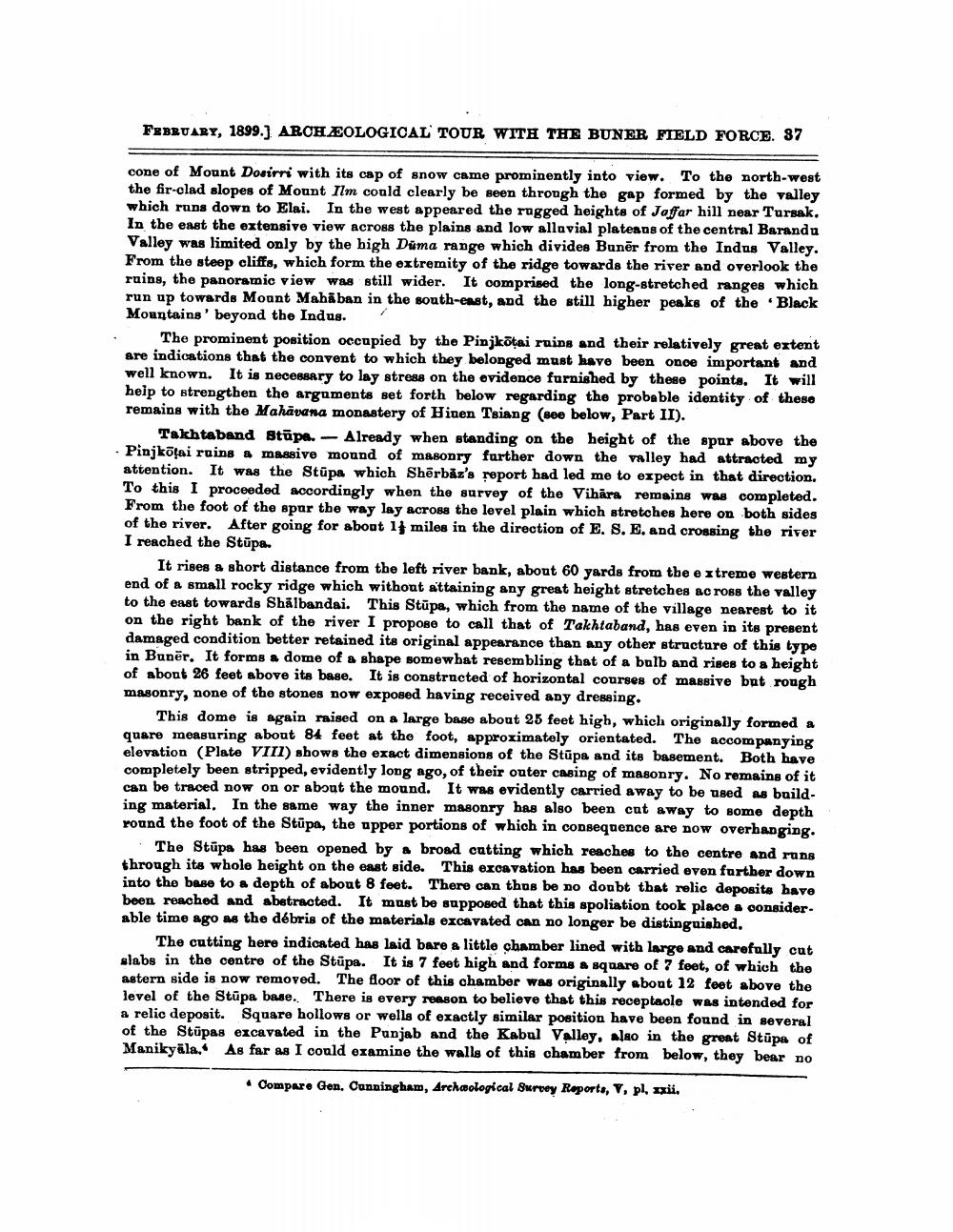________________
FEBRUARY, 1899.) ARCHÆOLOGICAL TOUR WITH THE BUNER FIELD FORCE. 87
cone of Mount Dosirri with its cap of snow came prominently into view. To the north-west the fir-clad slopes of Mount Ilm could clearly be seen through the gap formed by the valley which runs down to Elai. In the west appeared the ragged heights of Jaffar hill near Tursak. In the east the extensive view across the plains and low allovial plateans of the central Barandu Valley was limited only by the high Düma range which divides Bunēr from the Indus Valley. From the steep cliffs, which form the extremity of the ridge towards the river and overlook the ruins, the panoramic view was still wider. It comprised the long-stretched ranges which run up towards Mount Mahāban in the south-east, and the still higher peaks of the Black Mountains' beyond the Indus.
The prominent position occupied by the Pinjkotai ruins and their relatively great extent are indications that the convent to which they belonged must have been once important and well known. It is necessary to lay stress on the evidence furnished by these points. It will help to strengthen the arguments set forth below regarding the probable identity of these remains with the Mahāvana monastery of Hinen Tsiang (see below, Part II).
Takhtaband stūpa. - Already when standing on the height of the spar above the Pinjkõtai ruins a massive mound of Masonry farther down the valley had attracted my attention. It was the Stūpa which Shērbåz's report had led me to expect in that direction, To this I proceeded accordingly when the survey of the Vihars remains was completed. From the foot of the spar the way lay across the level plain which stretches here on both sides of the river. After going for about 11 miles in the direction of E. S. E. and crossing the river I reached the Stūpa.
It rises & short distance from the left river bank, about 60 yards from the extreme western end of a small rocky ridge which without attaining any great height stretches across the valley to the east towards Shālbandai. This Stūpa, which from the name of the village nearest to it on the right bank of the river I propose to call that of Takhtaband, has even in its present damaged condition better retained its original appearance than any other structure of this type in Bunër. It forms a dome of a shape somewhat resembling that of a bulb and rises to a height of about 26 feet above its base. It is constrncted of horizontal courses of massive but rongh masonry, none of the stones now exposed having received any dressing.
This dome is again raised on a large base about 25 feet high, which originally formed a quare measuring about 84 feet at the foot, approximately orientated. The accompanying elevation (Plate VIII) shows the exact dimensions of the Stūpa and its basement. Both have completely been stripped, evidently long ago, of their outer casing of masonry. No remains of it can be traced now on or about the mound. It was evidently carried away to be used as building material. In the same way the inner masonry has also been cut away to some depth round the foot of the Stūpa, the upper portions of which in consequence are now overhanging.
The Stüpa has been opened by a broad cutting which reaches to the centre and runs through its whole height on the east side. This excavation has been carried even further down into the base to a depth of about 8 feet. There can thus be no doubt that relic deposits have been reached and abstracted. It must be supposed that this spoliation took place a consider. able time ago as the débris of the materials excavated can no longer be distinguished.
The cutting here indicated has laid bare a little chamber lined with large and carefully cut slabs in the centre of the Stupa. It is 7 feet high and forms a square of 7 feet, of which the astern side is now removed. The floor of this chamber was originally about 12 feet above the level of the Stūpa base. There is every reason to believe that this receptacle was intended for a relic deposit. Square hollows or wells of exactly similar position have been found in several of the Stupas excavated in the Punjab and the Kabul Valley, also in the great Stupa of Manikyala. As far as I could examine the walls of this chamber from below, they bear no
• Compare Gen. Cunningham, Archeological Survey Roporto, V, pl. xxii.




